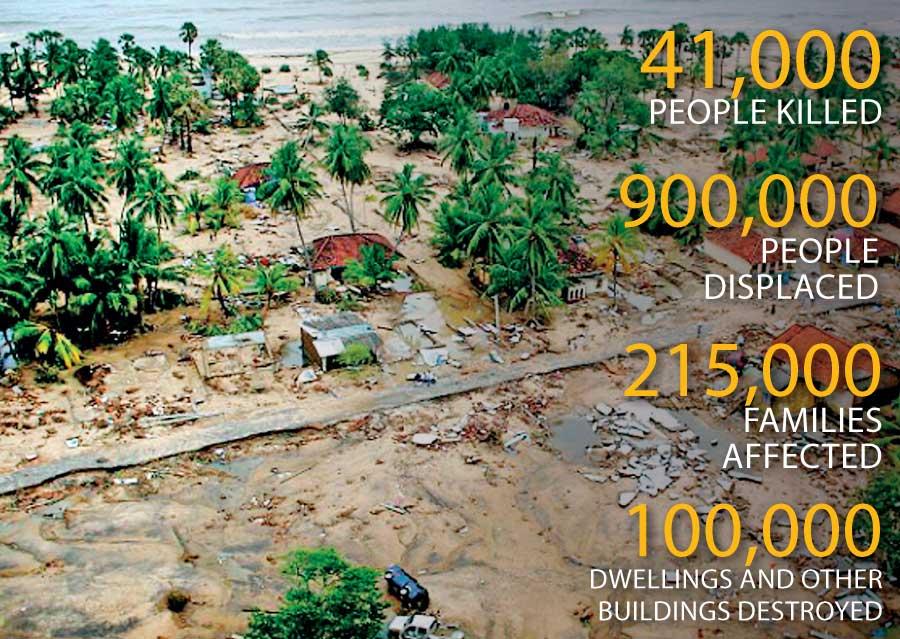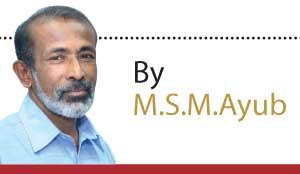Reply To:
Name - Reply Comment

Yesterday, more than 250,000 people in 14 countries including Sri Lanka, who perished in the 2004 tsunami catastrophe which is considered as the deadliest of its kind in recorded history, were commemorated by their family members and others alike.
In Sri Lanka alone, a staggering 41,000 people were killed according to unofficial reports albeit the official death toll stood at 31,000 while another 5,000 were said to have gone missing.  Roughly 900,000 people were displaced, 215,000 families affected and 100,000 dwellings and other buildings destroyed in Sri Lanka by the worst disaster in the history of the country. However, figures will never tell the real catastrophe our people encountered as former Soviet leader Joseph Stalin once said: “A single death is a tragedy, a million deaths is a statistic.” This was proved by the media which published many individual stories of the victims rather than official statistics
Roughly 900,000 people were displaced, 215,000 families affected and 100,000 dwellings and other buildings destroyed in Sri Lanka by the worst disaster in the history of the country. However, figures will never tell the real catastrophe our people encountered as former Soviet leader Joseph Stalin once said: “A single death is a tragedy, a million deaths is a statistic.” This was proved by the media which published many individual stories of the victims rather than official statistics
on the devastation.
"Had the LTTE not been arrogant and intransigent to bring the Package onto the negotiating table when it first encountered the Kumaratunga Government after the tsunami, it would have averted thousands of deaths that took place later"
The situation created by the killer wave on December 26, 2004 heavily impacted politics of several countries such as Indonesia and Sri Lanka, with Indonesia managing to resolve one of its deadliest separatist rebellions in the history while in Sri Lankan politics, drifting into destabilisation besides the country missing a golden opportunity to resolve its ethnic conundrum.
Many of the southerners might be praising the LTTE now for its arrogant politicisation in the aftermath of the Boxing Day catastrophe, unless there was a possibility for Tamils in the North and East to gain wider devolution powers to the then merged two provinces while saving thousands of lives including those of rebel leaders who were lost in the last phase of the war.
The separatist insurgencies in Indonesia and Sri Lanka had several parallels with separatist movements in both countries officially commencing in 1976. Gerakan Aceh Merdeka(GAM) or Free Aceh Movement at the Aceh Province in Northern Indonesia started its armed campaign for the secession and independence of the province from Indonesia in that year.
Interestingly, it was in the same year that Tamil United Front (TUF) changed its name to Tamil United Liberation Front (TULF) while adopting a resolution at its historic Convention in Vaddukoddai to carve out a separate State in the Northern and Eastern Provinces in Sri Lanka for Tamil-speaking people. Despite Tamils rebels having started to kill their opponents such as the then Jaffna Mayor Alfred Duraiappah the previous year 1975, it was only at the Vaddukkoddai convention that the idea of a separate State was formalised.
Another parallel between separatist wars in both countries was the two failed peace attempts among rebels and governments of respective countries in 2000 and 2002 with
international mediation.
President Chandrika Kumaratunga initiated Norwegian facilitated peace efforts in 2000 but failed with the government in Colombo facing multiple political upheavals. On one hand, she had to face the internecine bickering between her People’s Alliance (PA) and M.H.M. Ashraff’sSri Lanka Muslim Congress (SLMC) which was a constituent party of the ruling coalition and on the other, the LTTE had overrun the strategic Elephant Pass military complex in April 2000 while peace efforts were on.
Similarly, with the mediation of a Geneva-based organisation called Henry Dunant Centre (HDC) which was later known to be Centre for Humanitarian Dialogue, an agreement was reached between the Aceh militants and the Indonesian Government in 2000. The agreement called ‘Humanitarian Pause’ fell apart when fighting broke out soon.
Undaunted by the turn of events, Norwegians in Sri Lanka and HDC in Aceh ploughed ahead in their peace efforts culminating in ceasefire agreements by both countries in 2002. However, with violations of the ceasefire agreement by both sides and due to other political reasons, the agreements collapsed in about six months. In April 2003, the LTTE withdrew from peace talks while in May armed hostilities broke out in Aceh.
It was against this backdrop that the tsunami hit the two countries, especially in conflict-ridden areas . The Indonesian authorities and GAM leaders were swift to understand the gravity of the situation and came down from their positions to make real peace this time with the mediation by Finnish authorities led by former Finnish President
Martti Ahtisaari.
In mid-2005, the government agreed to grant greater autonomy to the Aceh Province and GAM rebels reciprocated with a pledge to lay down arms and renounce violence. And the peace holds in Aceh since. However, the situation in Sri Lanka was different. A part of the areas devastated by the tsunami was under the control of the LTTE while foreign aid received for relief and reconstruction work were with the government and thus the need of a joint mechanism between the government and the LTTE arose.
The LTTE attempted to seize this opportunity to gain political mileage rather than supporting the people hit by the killer wave and put forward a proposal for the creation of a joint mechanism for relief and reconstruction activities under the ceasefire agreement which was by then in
force for namesake.
"The LTTE attempted to gain political mileage rather than supporting the people hit by the killer wave and put forward a proposal for the creation of a joint mechanism for relief and reconstruction activities under the ceasefire agreement which was by then in force for namesake"
Under the proposal, the outfit wanted to handle relief and reconstruction within North-East including government-held areas and the mechanism it proposed was almost a blueprint for a separate State in the two provinces. Desperate in bringing the LTTE again to the negotiating table, the government led by President Chandrika Kumaratunga agreed to ink an agreement under this proposal whereas Janatha Vimukthi Peramuna (JVP), one of the two partners in the PA-led government was vehemently opposed to it. The JVP leaders threatened to quit the government if it went ahead with the agreement on the joint mechanism which was officially called Post-Tsunami Operational Mechanism Structure (P-TOMS) which they did in June 2005. This became a serious setback for the government which lost the majority in Parliament and brought about another wave of political chaos resulting in P-TOMS being dumped.
However, it was the first political encounter between the Chandrika Kumaratunga Government and the LTTE since the collapse of peace talks among the UNF Government and Tamil Tigers which could have been used to find a lasting solution to the ethnic issue. In fact, there was a set of the proposal at hand for the purpose and mood of the South was also such that they seemingly wanted a solution at any cost.
Kumaratunga had put forward a proposal ten years before in 1995 for the resolution of the ethnic conflict which was then commonly known as “The Package” under which Sri Lanka was named as a “Union of Regions” rather than being called as a Unitary State. In spite of the LTTE having rejected this proposal when it was first presented, the organisation’s advisor Anton Balasingham had told at a public meeting in Kilinochchi in 2003 that they could have accepted it.
On the other hand, frustrated by the unceasing bloodletting, the South had changed in a manner that not a single demonstration or statement of protest was seen or heard of when the UNF Government and the LTTE agreed for a federal form of government in late 2002. Besides, they including those who agitated against the peace process had expressed concern when the LTTE withdrew from the talks.
Had the LTTE not been arrogant and intransigent to bring the Package onto the negotiating table when it first encountered the Kumaratunga Government after the tsunami, it would have averted thousands of deaths that took place later. But the ignorance or underestimation of LTTE leader Velupillai Prabhakaran on the geopolitical situation in the region prompted him to believe India would allow a separate Tamil State being carved out near its southernmost State that housed around sixty million Tamils. The aftermath of the 2004 tsunami was thus added to the list of lost opportunities for peace in Sri Lanka.
Now that the Tamils have lost its two main bargaining tools - the LTTE and India - President Gotabaya Rajapaksa had said he did not believe in devolution as a solution to the ethnic issue.